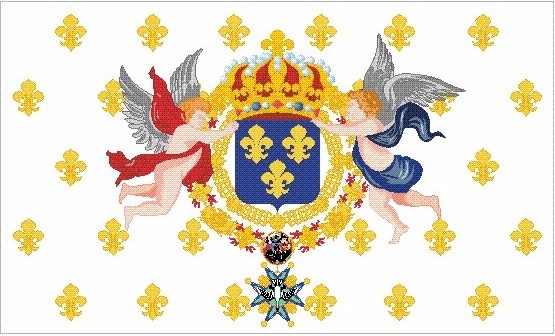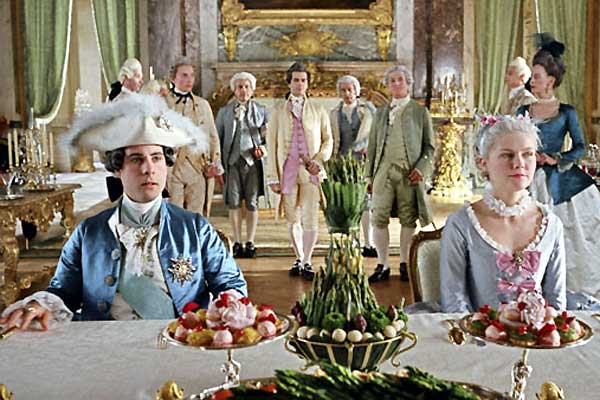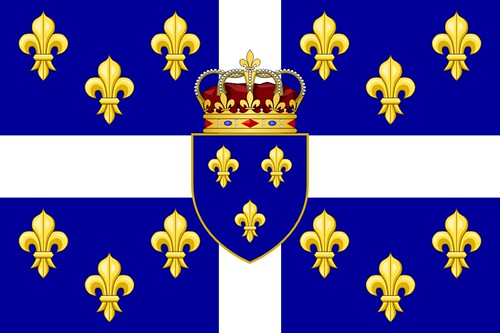Le royaume de France

Territories: Kingdom of France, Principality of Corsica, Duchy of Monaco, Independent State of the Congo, Independent State of Cote d’Ivoire
Approximate population: 133 million (60 million French, 73 million Africans)
GDP per capita: 30, 503 (France)
Total GDP: 2.806 Trillion (France)
Capital: Versailles (de facto), Paris (de jure)
Motto: Montjoie Saint Denis!
Anthem: Le Te Deum
Languages: French, Gallo-African, Tribal dialects
Religion: Roman Catholicism
Government: Absolute monarchy {male primogeniture}
Important Kings
843–877 Charles the Bald
987–996 Hugh Capet
1180–1223 Philip II of France
1589–1610 Henry IV (Founder of the Bourbon Dynasty)
1643–1715 Louis XIV (“The Great”)
1774–1792 Louis XVI
(Between the Revolution of 1792 and the Restoration of 1815 was the French Interregnum during which time the French Republic under Philippe Égalité and the French Empire under Napoleon Bonaparte held respective power.)
1815-1830 Louis XVII
1830-1837 Charles X
1837-1851 Charles XI
1851-1876 Louis XVIII
1876-1878 Louis XIX
1878-1891 Charles XII
1891-1915 Louis XX
1915-1919 Louis XXI
1919-1940 Louis Auguste (“The Terrible”)
1940-1972 Louis Auguste II (“The Grand”)
1972-Present: Louis-Auguste III (“The Beloved”)
Issue:
Louis Auguste, fils de France, Dauphin of France
Louis, fils de France, duc d’Anjou
Princess Marie Adélaïde
Princess Victoire
Princess Sophie
First Minister: Jean-Frédéric Phélypeaux, comte de Maurepas
Legislature: Estates General [Officially dissembled as of 1919]
Overview
The status of the Kingdom of France in 2016 reflects the centuries’ long struggle of an absolutist, Catholic monarchy adapting with greater and lesser degrees of success to a changing world. As such the country is a mish-mash of the old and the new and of the liberal and the reactionary. There have been three major revolutions in French history, of which only the 1792 Revolution was successful. The revolutions of 1848 and 1919 were each successfully repressed, and with those successive rebellions the more representative institutions of France withered away, replaced by more direct monarchical control. The Revolution of 1919 was particularly sanguine, so much so that the Bastille was rebuilt into a grotesque thirty story concrete block that dominated and dominates still the Paris skyline, that the Estates General was dissembled with many Third Estate representatives arrested, and that at the king’s command Catholic primates in France declared trade unionism ‘a sin of pride.’
In 2014, in the wake of the Gull Flag Revolution, fresh disturbances broke out across France, namely in the metropoles of Paris and Marseille, but the crown’s swift and summary response prevented the ‘July Riots’ from becoming a true revolution. Using modern surveillance techniques and primitive methods of ‘enhanced interrogation’ the crown nipped the revolutionary movement in the bud; and when protests turned into riots the gendarmerie and certain military units responded with deadly force. It is estimated that a thousand rioters were killed and six times as many placed into permanent custody in the Bastille. No official numbers, of course, are available.
It is useful in discussing the ‘July Riots’ of 2014 because they demarcate the point at which the government organs of France became fully subsumed into the hands of the king. In August 2014 King Louis Auguste III employed his prerogative as king and used a lettre de cachet, a ‘letter of the seal’ which could not be appealed and dissembled the judiciary structure itself in France. In place of courts of law King Louis Auguste III created Courts of Intendancy where a single arbiter, nearly always a underprivileged aristocrat eager to demonstrate his fealty to the crown, imposes extra-judicial verdicts the sentences of which are under the jurisdiction of only the king himself. Additionally unofficial security forces in France which had long been operating in cabinets noires were codified by that selfsame lettre de cachet into a proper secret police answerable only to the crown, the Maréchaussée. A police state, for all intents and purposes, had been erected.
Now, all this talk of revolution and repression might lead the reader to the understandable position that France is a totalitarian state under the iron fisted rule of a dictator. But this is in fact hardly the case.
Although some kings, notably Louis Auguste I, prefer to take direct roles in governance most, notably the present king and his father Louis Auguste II, leave rulership of the country to a handful of ministers who owe their positions to birth or talent—most of the time, to both. Given that a Prime Minister would be an oxymoron in an absolute monarchy the Bourbons (at least, most Bourbons) have since the time of Louis XVII relied on ‘First Ministers’: powerful individuals who usually chair several key ministries and have a mandate from the king to govern. Presently the First Minister is Jean-Frédéric Phélypeaux, comte de Maurepas. He is a septuagenarian old-hand at politics whose mix of practical diplomacy and ‘divide-and-conquer’ domestic administration (pitting different groups against each other in an intricate fashion) was overruled only once…after the ‘July Riots’…when the king was forced by reactionary elements of the court to ‘pull out all the stops’. It is largely because of this old political sphinx that the current king, one year his junior at 76, earned his titled ‘the Beloved’. Because, despite the fevered protests following the down fall of the Shield’s monarch, the past decades in France had seen a constant rise in living for the high, the middle, and the low; had seen nearly universal enrollment in a perhaps better than adequate government health system; had seen fairly generous pension programs created; had seen the institution of free higher education. Thought, as a note, it is worth mentioning that the Catholic run education system teaches only the hard sciences and French grammar. Liberal arts programs (excluding theology), having always been viewed with suspicion if not hostility, were never instituted and so never had to be cancelled. And in all these decades France has had peace. Not to mention positive, if not amicable, relations with her neighbors.
Of course the secret price of La Belle Époque (as the last two decades of the old millennium and the first decade of the new is known) has been the abject abuse and rapine of the Kingdom’s African colonies. Strip mining, forced relocation of native populations to get at resources, the preplanned addicting of entire populations to third rate narcotics, has been a common story in France’s African ‘Free States’ over the past generation. Stories of such abuses, largely committed by the Royal Africa Company (of which the Bourbons are 51% majority shareholders) are covered up well enough to be sure…but it is a fact that many, too many, Frenchmen (notwithstanding a quiet minority that bubbles up in protest every odd decade) have a good idea of why prices are so cheap and benefits so generous. But faced on the one hand with tangible benefits and on the other by a swift truncheon should they take to the streets, most Frenchmen simply take the benefits and ask no questions.
That said, France in 2016 can be a charming country. In many respects it is a living fairy tale from picturesque country villages to the glittering palaces of the elite. The king and his court are remote from the population, living in a never ending party that indulges itself in a perpetual dance across several sprawling chateaux—depending precisely on the time of year—of which the principal and most notable is the Chateau de Versailles. Since the time of Louis-Auguste III’s great-grandfather the royal family only comes to Paris for Easter Mass at Notre Dame and to the Louvre Palace for His Most Christian Majesty’s annual birthday ball: traditionally held in October to mark the opening of the Court’s fall season. The royal family does not ‘do’ television, and most people see the king mostly on their livre notes. To be sure, many a duc and comte and marquis keeps a fashionable address is Paris…but the beating heart of aristocratic life is with the king and his court.
But this leaves governance in the hands of largely capable ministers, and so life largely carries on fairly well for all subjects of the realm, not merely the great and the good.
French couture, both the elaborate costumes of the Court and more avant-garde productions by Yves Saint Laurent et al. must surely give the world an acme of fashion. Paris remains a city of lights, though the glitter shines in the shadows of the cyclopean Bastille. French cuisine remains superb, and perhaps more innovative than possible in other timelines, given that the Bourbons and the nobility demand ever more elaborate and rich fare to sate their jaded appetites. And, certainly, the French continue to field so damn good football squads.




